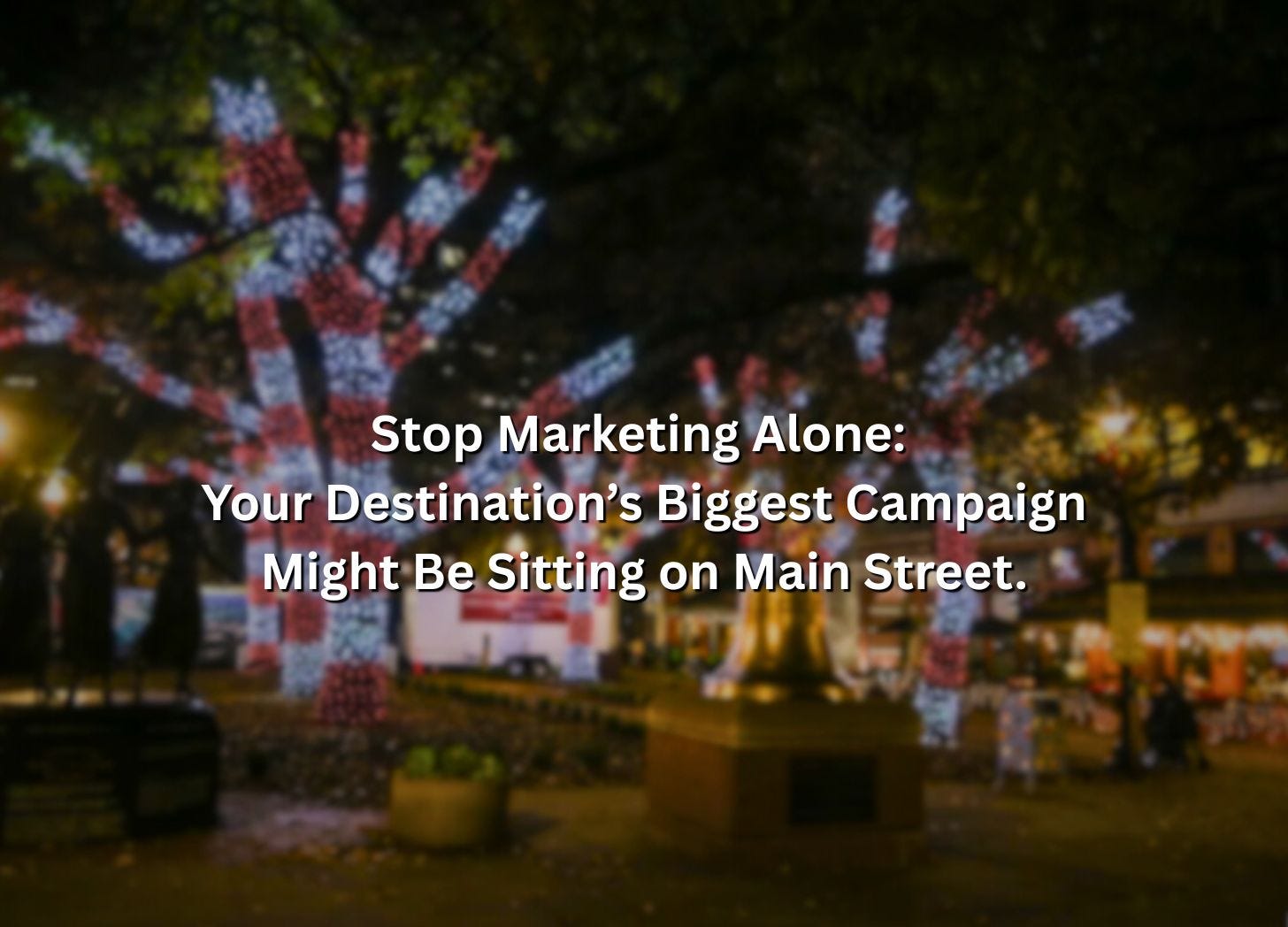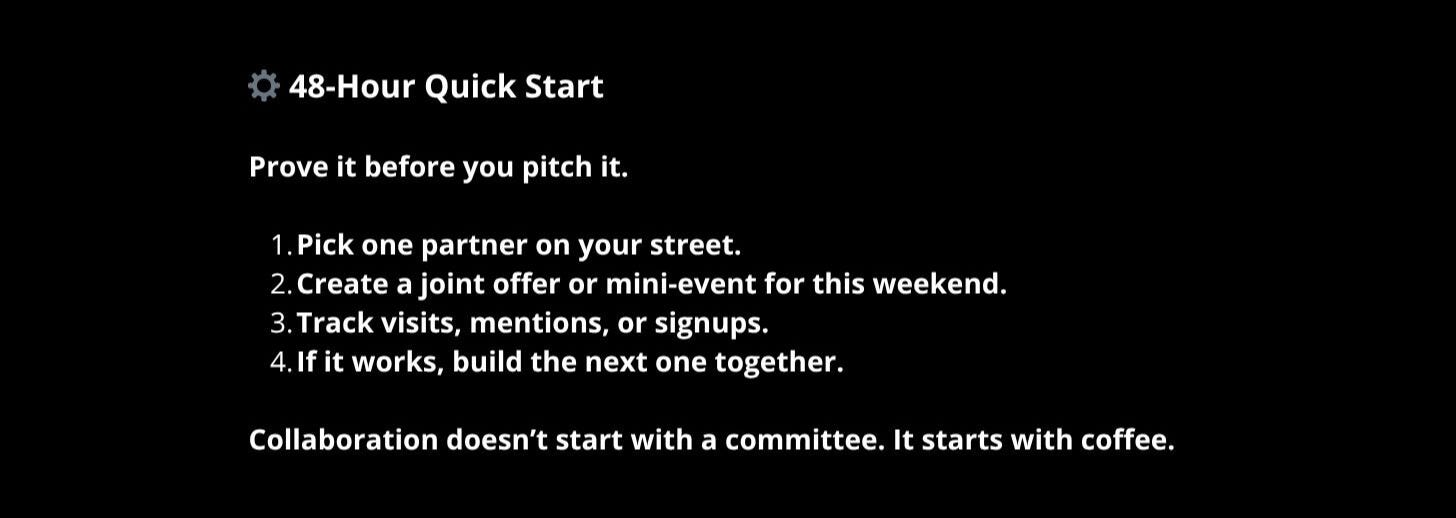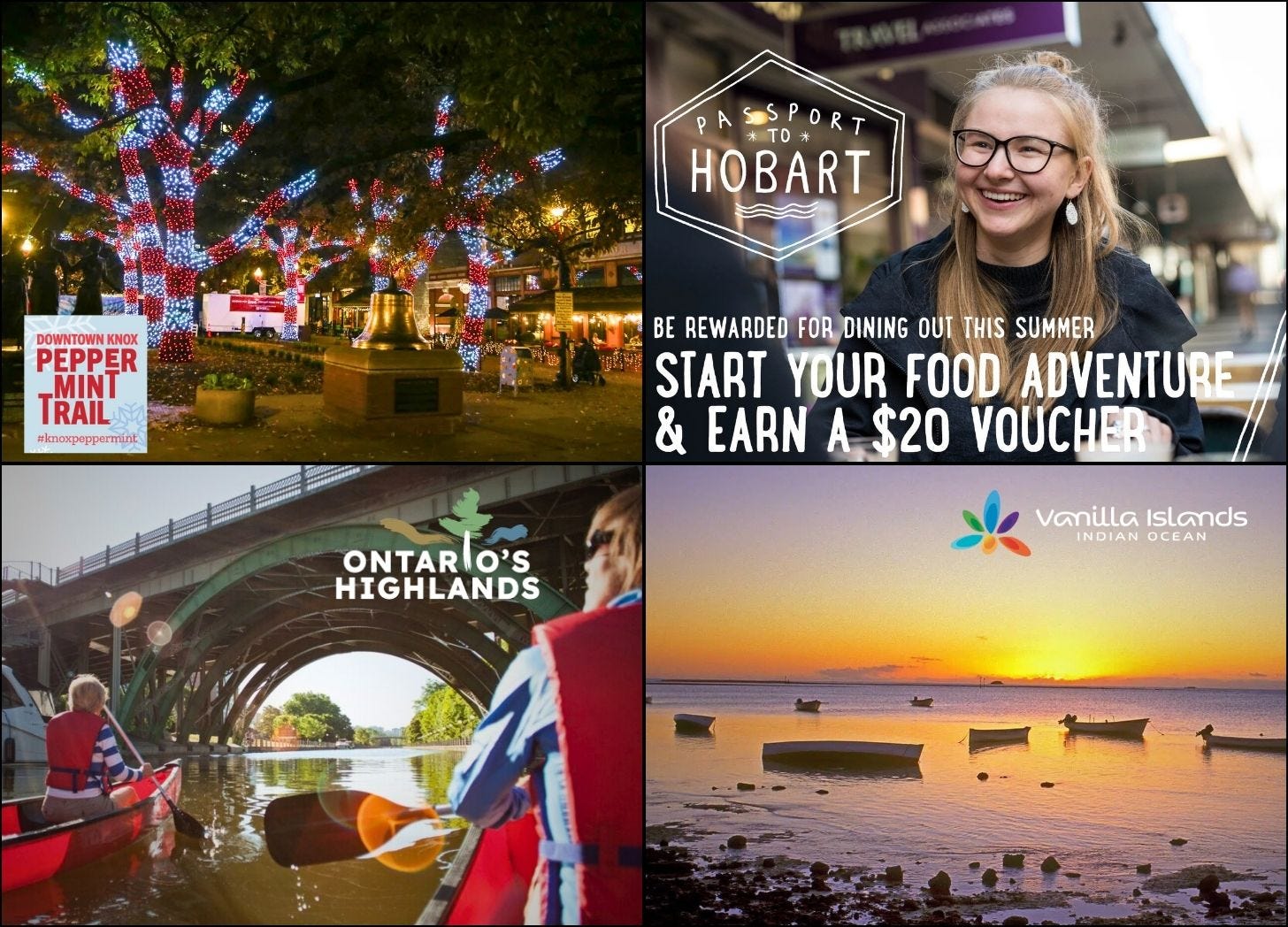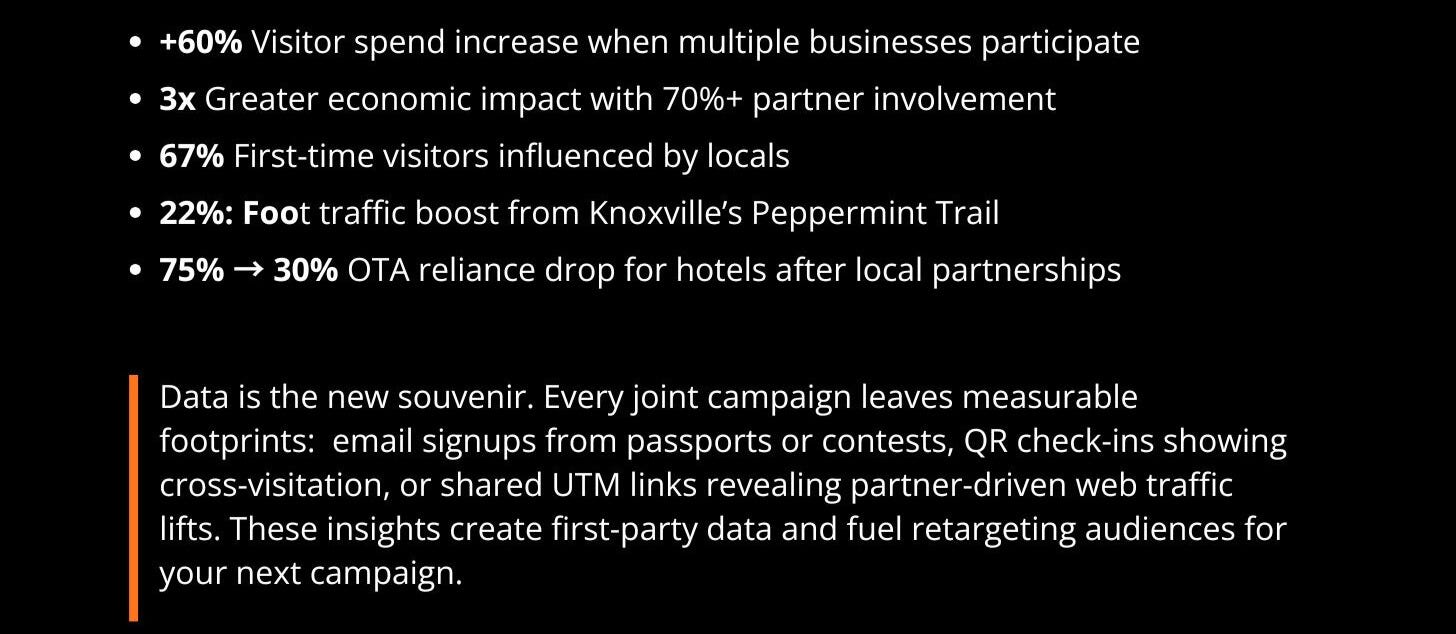Destination Sunday: Stop Marketing Alone
Why Your Destination’s Biggest Campaign Might Be Sitting on Main Street
Everyone’s spending more to be seen—and getting less in return.
Budgets keep rising, results keep shrinking, and yet another “big idea” gets pitched in a boardroom while Main Street quietly fades after sunset.
Let’s be honest, every town has that one empty storefront with the For Lease sign everyone pretends not to see. Every DMO or hotelier hoping the next campaign will fix it.
Here’s the truth: your next great campaign isn’t a video, a logo, or a viral moment. It’s your community.
Visitors don’t fall in love with billboards. They fall in love with people. The baker who remembers their order, the musician on the corner, the innkeeper who points them to the locals’ favorite spot.
Collaboration isn’t a feel-good slogan. It’s the only marketing strategy that multiplies value instead of dividing attention.
And the places proving it. From Knoxville’s Peppermint Trail to Hobart’s Shop Local Passport, didn’t outspend anyone. They just stopped marketing alone.
The Real Campaign Is Already Happening on Main Street
In Knoxville, Tennessee, forty small businesses joined forces for The Peppermint Trail, a holiday passport linking cafés, boutiques, and restaurants. No massive ad spend—just shared visibility and local pride. The outcome? A 22 percent lift in foot traffic and more overnight stays.
In Hobart, Tasmania, merchants launched a Shop Local Passport through Stamp Me’s rewards app, letting visitors earn perks for supporting neighborhood businesses. It boosted repeat visits and helped even the smallest storefronts regain visibility post-pandemic.
In Ontario’s Highlands, lodgings, guides, and artisans pooled modest budgets for a shared winter photo campaign. The content gave the region a cohesive, professional image no single operator could afford alone.
And across the Vanilla Islands (Réunion, Seychelles, Mauritius), neighboring nations joined under one narrative. The result? Higher visitation per marketing dollar — and proof that collaboration scales.
From cafés and craft studios to yoga instructors and nonprofits, cooperation converts.
Why Collaboration Wins
Turns out, the data’s on Main Street’s side.
Research from Wang & Fesenmaier on Elkhart County, Indiana showed that rural destinations thrive when they formalize collaboration. Orlando’s Green Destination initiative proved the same on a city scale: authenticity beats ad spend.
And across global benchmarks, DestinationNEXT and Sojern studies agree — DMOs that leverage local alliances outperform those that rely solely on paid media. Collaboration isn’t charity; it’s measurable ROI.
The Math Behind Collaboration
What Collaboration Looks Like in Practice
The beauty of this model is its scalability.
Launch a shared passport or themed trail. A hotel anchors lodging, a café adds a “passport perk,” a gallery hosts a Sip & Sketch night, and a wellness studio offers a discount. Each QR check-in captures visitor data that can be anonymized and analyzed across the network.
Create a joint content calendar. Share each other’s posts, cross-tag partners, and highlight overlapping audiences to expand reach without extra spend.
Integrate simple digital tools like Bandwango or Stamp Me to track participation, offer rewards, and export analytics.
Measure what matters: dwell time, repeat visits, partner mentions, and local web traffic. Collaborative campaigns can drive measurable spikes in website sessions and feed remarketing lists for future destination ads.
Ultra-lean collaboration tactics:
Run a barter-based social swap, trade Instagram posts, newsletter mentions, or shelf space.
Bundle micro-events like “latte + gallery tour” for under $100 shared costs.
Collect visitor emails through shared giveaways or digital passports.
Small steps build data, trust, and proof that teamwork outperforms any single ad spend.
Making Collaboration Accessible
Not every business has a marketing team, but every business has a story.
Use sponsorship tiers: hotels or DMOs cover tech; micro-operators contribute local offers or prizes.
Offer in-kind contributions, photos, space, or signage instead of cash.
Allow phased participation, so smaller operators can join when ready.
Include equity partners, minority-owned shops, cultural groups, or rural artisans. Their voices expand your destination’s story and align with 2025 inclusivity priorities highlighted by IATA and DCI.
Collaboration only works when everyone —not just those with bandwidth or deep pockets —has a seat at the table.
Overcoming the Solo Mindset
Let’s be real. Collaboration sounds easy until you try it.
Suddenly, everyone’s calendar is full, the group chat’s silent, and no one wants to split the bill for the ad design.
That’s normal. The fix isn’t more meetings; it’s better communication.
Start small.
Host a “coffee and wins” meetup. Talk about what actually worked this month.
Trade visibility. Share each other’s posts. Celebrate your partners publicly.
And measure what matters. A one-page feedback form. A shared Google Sheet. A quick look at Google My Business insights. Review those numbers together every month — not to point fingers, but to celebrate proof.
If you’re new to collaboration, begin with one seasonal event or trail. The goal isn’t perfection… it’s momentum.
One café owner in Hobart put it best:
“Once we saw our sales rise during the passport weekend, even the skeptics joined next time.”
That’s how you shift from competition to collaboration — one shared win at a time.
Sometimes the Road is Bumpy
Early experiments don’t always go smoothly, and that’s the point.
In Vermont’s Mad River Valley, restaurant partnerships struggled with pricing alignment until the chamber stepped in to facilitate. Within one season, weekend bookings rose 18%.
In coastal Maine, an arts district tested rotating “featured gallery” status to even out visitor flow. Within months, more consistent traffic created a stronger year-round circuit.
These weren’t failures; they were adaptive learning cycles, proof that iteration beats inertia.
Sustaining Success
The strongest destinations treat collaboration as an engine, not an event.
After the campaign ends:
Keep a shared content library and media folder.
Host an annual planning day.
Build a year-round communication hub on Slack or WhatsApp.
Use a simple meeting checklist to keep goals visible and action consistent.
Over time, one-off efforts evolve into a self-sustaining marketing ecosystem.
And for DMOs tracking performance, integrated dashboards now allow anonymized QR or check-in data to show cross-visitation — proving, with numbers, that Main Street collaboration drives measurable ROI.
The Modern Marketing Mix: Online + On Main
Main Street and digital storytelling are inseparable.
Use shared hashtags and geotags to unite your narrative.
Encourage user-generated content: visitors sharing their favorite stops or passport check-ins.
Collaborate with micro-influencers who prefer real moments over staged ads.
Align content with hospitality partners — that hotel reel of guests exploring the market benefits everyone.
Experiment with hybrid events: livestream your festival, run a hashtag contest, or co-host a “virtual maker tour.”
Every on-the-ground collaboration creates digital lift, more engagement, more first-party data, and more retargetable audiences for your next campaign.
The Takeaway
Marketing louder won’t save your destination. Marketing together will.
Because every ad fades, but shared stories stick.
They turn neighbors into partners, guests into advocates, and small towns into places people talk about.
So skip the next brainstorm deck. Take a walk down Main Street instead.
Say hi to the café owner, the artist, the yoga teacher, or the librarian.
Then ask the only question that really matters:
“What could we build together that none of us could build alone?”
And when someone says, “That would never work here,” smile, because that’s exactly what every successful destination said before it did.
The future of your destination isn’t in your ad budget.
It’s already next door — lights on, ready to share the spotlight.








This is terrific advice and I've never understood the reticence or the lethargy to doing this.
Of course all businesses are not financially equal but each business in tourism especially, relies on one another.
No point in staying in a hotel if there's nothing to do nearby.
Bringing people to a town requires a purpose and OK it takes a bit of effort but put together a package of options which encourages visitors and everyone benefits.
IMO it's one of the most obvious marketing ploys there is.